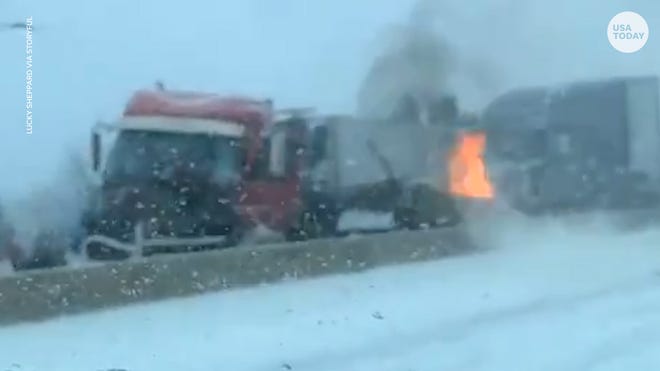Along with cold weather, many may have to do with frozen pipes. The American Red Cross offers several tips on thawing and protecting the pipes in your home.
On the organization’s website, when the water freezes, it expands, which puts pressure on metal or plastic pipes.
“Regardless of the strength of a container, expanding water can cause pipes to break,” said the Red Cross.
More:150 million people are on winter advice as an “unprecedented” storm stretches across 25 states. Texas sees power outages
The most common pipes that freeze are:
- Pipes exposed to extreme cold, such as outdoor hose bibs, pool utility lines, and sprinkler lines
- Water supply lines in unheated indoor areas such as basements and crawl spaces, attics, garages or kitchen cupboards
- Pipes that run against exterior walls that have little or no insulation
How to protect pipes from freezing
- Before the onset of cold weather, protect your pipes from freezing by following the recommendations below:
- Drain the water from the swimming pool supply lines and sprinkler system according to the manufacturer’s or installer’s instructions. Do not put antifreeze in these lines unless directed to do so. Antifreeze is harmful to the environment and dangerous to people, pets, wildlife, and landscaping.
- Remove, drain, and store tubing used outdoors. Close the indoor valves that feed the hose bibs outdoors. Open the outer hose bibs to allow the water to drain away. Keep the outside valve open to allow the water remaining in the pipe to expand without breaking the pipe.
- Add insulation to attics, basements, and crawl spaces. The insulation maintains higher temperatures in these areas.
- Look for other areas of the house that have water supply lines in unheated areas. Look in the garage and under kitchen and bathroom cabinets. Both hot and cold water pipes in these areas should be insulated.
- Consider installing certain water pipe insulation products, such as a “pipe socket,” or installing UL Listed “heat tapes,” “heat cables,” or similar materials on exposed water pipes. Newspapers can insulate and protect exposed pipes to some extent – even a quarter inch of newspaper can provide significant protection in areas that don’t typically experience frequent or prolonged freezing temperatures.
- Consider routing exposed pipes for better protection from freezing.
How to Prevent Frozen Pipes in Your Home
- Keep garage doors closed when there are water pipes in the garage.
- Open the doors of the kitchen and bathroom cabinets to allow the warmer air to circulate around the plumbing. Make sure harmful detergents and household chemicals get out of the reach of children.
- If the weather is very cold outside, drain the cold water from the faucet, which is served by exposed pipes. Running water through the pipe – even with a trickle – prevents the pipes from freezing.
- Keep the thermostat at the same temperature both day and night. If you temporarily stop using lower night-time temperatures, this can lead to higher heating bills. However, you can prevent a much more costly repair if the pipes freeze and burst.
- If you go out in cold weather, leave the heating in your house on and set a temperature no less than 55 degrees.
More:“Controlled business interruptions” are possible as City Utilities draws attention to “extreme” natural gas shortages
How to thaw frozen pipes
- If you turn on a faucet and only a trickle comes out, you suspect a frozen pipe. Possible places for frozen pipes are outside walls or places where your water service enters your home through the foundation.
- Keep the tap open. When you handle the frozen pipe and the frozen area starts to melt, water will flow through the frozen area. Running water through the pipe will help melt ice in the pipe.
- Apply heat to the pipe section by wrapping an electric heating pad wrapped around the pipe, an electric hair dryer, portable space heater (keep away from flammable materials), or pipes with towels soaked in hot water. Do not use a blowtorch, kerosene or propane heater, charcoal stove, or any other device with an open flame.
- Apply heat until full water pressure is restored. If you cannot find the frozen area, if the frozen area is inaccessible, or if you cannot thaw the pipe, contact a licensed plumber.
- Check all the other faucets in your house to see if you have any additional frozen pipes. If one pipe freezes, so can others.


Comments are closed.